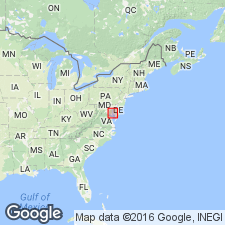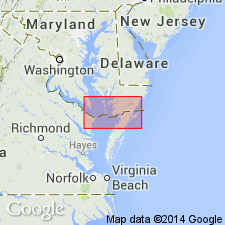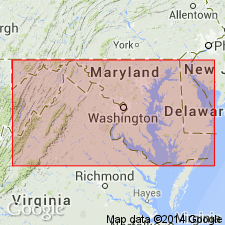
- Usage in publication:
-
- Plum Point marls member
- Modifications:
-
- Named
- Dominant lithology:
-
- Marl
- Clay
- AAPG geologic province:
-
- Atlantic Coast basin
Summary:
Named Plum Point marls member for Plum Point, Calvert Co., MD. Unit is a series of sandy clays and marls in which are embedded large numbers of organic remains, including diatoms. It is of bluish-green to grayish-brown and buff color. The Plum Point is considered the top member of the Calvert formation and overlies the Fairhaven diatomaceous earth member and is of Miocene age.
Source: GNU records (USGS DDS-6; Reston GNULEX).

- Usage in publication:
-
- Plum Point marl beds*
- Modifications:
-
- Overview
- AAPG geologic province:
-
- Atlantic Coast basin
Summary:
Data from the section in the Haynesville coreholes, 0.65 mi northwest of Haynesville, (lat 37 57'13"N, long 76 60'26"W), Richmond Co., VA: The lower shelly sand beds of the Calvert are equivalent to the upper Fairhaven Member or the lower Plum Point Marl Member in MD. Overlying the shelly sand beds are 7 phosphatic diatomaceous fining-upward sequences. The lower 2 are named the informal Plum Point marl beds, equivalent to the Plum Point Marl Member in MD. The upper 5 sequences are named the informal Calvert Beach beds, equivalent to the Calvert Beach Member in MD.
Source: GNU records (USGS DDS-6; Reston GNULEX).

- Usage in publication:
-
- Plum Point Marl Member*
- Modifications:
-
- Overview
- Areal extent
- AAPG geologic province:
-
- Atlantic Coast basin
Summary:
Described in this report as a series of shelly sands interbedded with diatomaceous clays. Series contains a number of identifiable pulses: first pulse includes "Zones 4-9" (of Shattuck, 1904), second pulse includes "Zones 10-11," the third pulse includes "Zones "Zones 12-13," and the fourth pulse includes "Zones 14-16." Zone 16 at Calvert Beach MD, was originally included in the Choptank Formation. Plum Point Marl Member is recognizable only as far south as the Westmoreland bluffs in Westmoreland Co., VA. Farther to the southeast, beds equivalent to the Plum Point grade into silty, diatomaceous clays. Unconformably overlies the Fairhaven Member; underlies Calvert Beach Member. Age of both members considered early middle Miocene.
Source: GNU records (USGS DDS-6; Reston GNULEX).
For more information, please contact Nancy Stamm, Geologic Names Committee Secretary.
Asterisk (*) indicates published by U.S. Geological Survey authors.
"No current usage" (†) implies that a name has been abandoned or has fallen into disuse. Former usage and, if known, replacement name given in parentheses ( ).
Slash (/) indicates name conflicts with nomenclatural guidelines (CSN, 1933; ACSN, 1961, 1970; NACSN, 1983, 2005, 2021). May be explained within brackets ([ ]).

